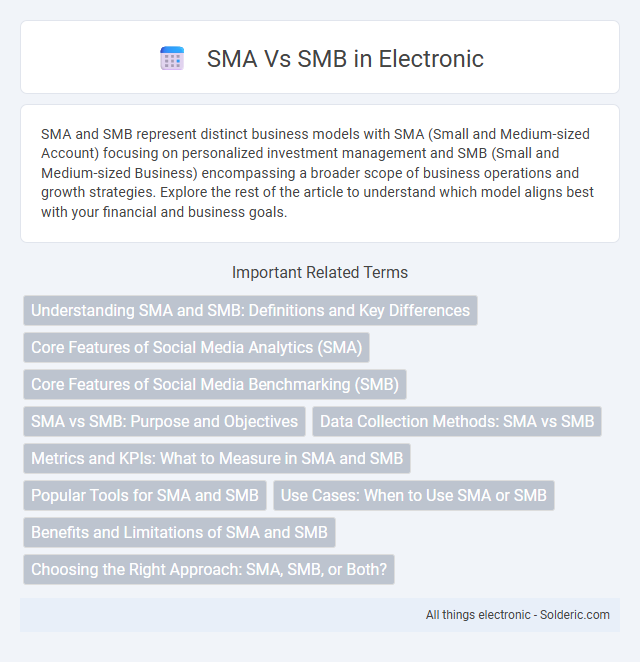SMA and SMB represent distinct business models with SMA (Small and Medium-sized Account) focusing on personalized investment management and SMB (Small and Medium-sized Business) encompassing a broader scope of business operations and growth strategies. Explore the rest of the article to understand which model aligns best with your financial and business goals.
Comparison Table
| Feature | SMA (SubMiniature version A) | SMB (SubMiniature version B) |
|---|---|---|
| Connector Type | Threaded RF coaxial connector | Snap-on RF coaxial connector |
| Frequency Range | Up to 18 GHz (some up to 26.5 GHz) | Up to 4 GHz |
| Impedance | 50 ohms | 50 ohms |
| Size | Smaller and more compact | Larger than SMA, but smaller than SMB |
| Connection Mechanism | Threaded coupling for secure connection | Snap-on coupling for quick connect/disconnect |
| Typical Application | High-frequency RF and microwave systems | Medium-frequency RF applications, quick connect needs |
| Durability | High durability, good mechanical strength | Moderate durability, focused on ease of use |
Understanding SMA and SMB: Definitions and Key Differences
SMA (Specialized Market Access) targets specific, niche market segments, while SMB (Small and Medium-sized Businesses) refers to companies based on size and revenue metrics. SMA strategies emphasize tailored marketing approaches to engage distinct audiences, whereas SMB classification helps define business scale for resource allocation and support services. Understanding these distinctions enables you to optimize marketing efforts and business development for targeted growth.
Core Features of Social Media Analytics (SMA)
Social Media Analytics (SMA) core features include real-time data tracking, sentiment analysis, and audience segmentation, enabling businesses to monitor brand reputation and measure campaign performance effectively. Advanced SMA tools leverage machine learning algorithms to identify trends, patterns, and influencers, providing actionable insights for targeted marketing strategies. Integration capabilities with multiple social platforms and comprehensive reporting dashboards facilitate data-driven decision-making and optimize customer engagement.
Core Features of Social Media Benchmarking (SMB)
Social Media Benchmarking (SMB) offers core features including competitor analysis, allowing brands to compare engagement metrics, follower growth, and content performance across multiple platforms. It provides real-time tracking of key performance indicators (KPIs) such as reach, impressions, and sentiment analysis to gauge brand reputation and audience response. Automated reporting tools streamline the evaluation process, enabling data-driven decisions to optimize social media strategies effectively.
SMA vs SMB: Purpose and Objectives
SMA (Separately Managed Account) offers personalized portfolio management tailored to individual investor goals, while SMB (Small and Medium-sized Business) focuses on providing products or services to a market segment defined by company size. The primary purpose of SMA is to deliver customized investment strategies with direct ownership of securities, whereas SMB aims to grow business operations and increase market share within its category. Objectives for SMA center on optimizing risk-adjusted returns for the investor, while SMB targets revenue growth, operational efficiency, and competitive advantage in its industry.
Data Collection Methods: SMA vs SMB
Social Media Analytics (SMA) employs data collection methods like API integration, web scraping, and sentiment analysis to gather real-time user interactions across platforms such as Twitter, Facebook, and Instagram. In contrast, Social Media Benchmarking (SMB) relies on aggregating key performance indicators (KPIs) like engagement rates, follower growth, and share of voice from industry competitors to enable comparative analysis. SMA prioritizes unstructured data extraction for sentiment and trend detection, whereas SMB emphasizes structured data to establish performance standards within specific market segments.
Metrics and KPIs: What to Measure in SMA and SMB
Tracking revenue growth, customer acquisition cost (CAC), and net promoter score (NPS) are essential KPIs to measure in both Small and Medium-sized Enterprises (SMEs) and Small and Medium-sized Accounts (SMAs). You should also focus on churn rate and lifetime value (LTV) to understand customer retention and profitability in SMB markets, while SMAs require detailed account engagement metrics and deal velocity to optimize relationship management. Analyzing these metrics helps tailor strategies that drive sustainable growth in each segment.
Popular Tools for SMA and SMB
Popular tools for Social Media Analytics (SMA) include Hootsuite, Sprout Social, and Brandwatch, which provide in-depth data on audience engagement, sentiment, and campaign performance. In contrast, Social Media Marketing (SMB) often relies on platforms like Buffer, Canva, and Mailchimp to create, schedule, and optimize marketing content for better brand visibility and customer reach. Your choice of tools should align with whether your goal is to analyze social behavior or actively promote your brand through targeted campaigns.
Use Cases: When to Use SMA or SMB
SMA (Smart Managed Switch) is ideal for small to medium businesses requiring advanced features like VLANs, QoS, and limited Layer 3 routing to optimize network performance and security. SMB (Small and Medium Business) solutions typically cover a broader range of network devices, including unmanaged and managed switches, routers, and firewalls designed to support diverse business needs and scalability. You should choose SMA for more granular network control in environments demanding specific traffic management, while SMB solutions suit businesses seeking comprehensive, scalable networking infrastructure.
Benefits and Limitations of SMA and SMB
SMA (Static Microsegmentation Architecture) offers enhanced security and granular control by segmenting networks at the device level, reducing lateral movement of threats, but it can be complex to implement and manage in large environments. SMB (Small and Medium-sized Business) networks benefit from cost-effective and scalable solutions that fit limited budgets, yet they often face limitations in advanced security features and infrastructure resilience. Understanding these benefits and limitations helps you choose the right strategy to balance security needs with operational efficiency.
Choosing the Right Approach: SMA, SMB, or Both?
Choosing between Social Media Advertising (SMA) and Social Media Branding (SMB) depends on business goals, target audience, and budget. SMA delivers immediate results through targeted campaigns and measurable ROI, ideal for lead generation and sales conversions. SMB builds long-term brand loyalty and engagement by fostering community and trust, making it essential for sustained growth, and combining both strategies often maximizes market impact.
SMA vs SMB Infographic

 solderic.com
solderic.com